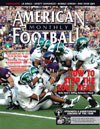AMERICAN FOOTBALL MONTHLY THE #1 RESOURCE FOR FOOTBALL COACHES
Article CategoriesAFM Magazine
|
The Strength Report: University of South Florida - Total Body MovementsWhy Total Body Movements?by: Ron McKeefery Asst. Athletic Director, Strength & Conditioning, University of South Florida © More from this issue Like anything else, itís a strength and power game you get from resistance training. Thatís why most athletes do both total body movements and Olympic lifts. The other reason itís important is to ensure multiple joint action and full extension. More specifically, triple extension of the ankle, knee, and hip. We incorporate that into our lifting strategy as well as work with injury prone areas with all the players. We also train multiple muscle groups and attempt to be as time efficient as possible. Our goal is to keep the athletes in shape year-round with the metabolic side of the total body movement. Examples and Teaching Progressions Athletes have a wide range of training history. Some of our athletes have lifted throughout their high school careers and others have never seen the weight room. Our ....The full article can only be seen by subscribers. Subscribe today!
|
|
|||||||
| HOME |
MAGAZINE |
SUBSCRIBE | ONLINE COLUMNISTS | COACHING VIDEOS |
Copyright 2025, AmericanFootballMonthly.com
All Rights Reserved





